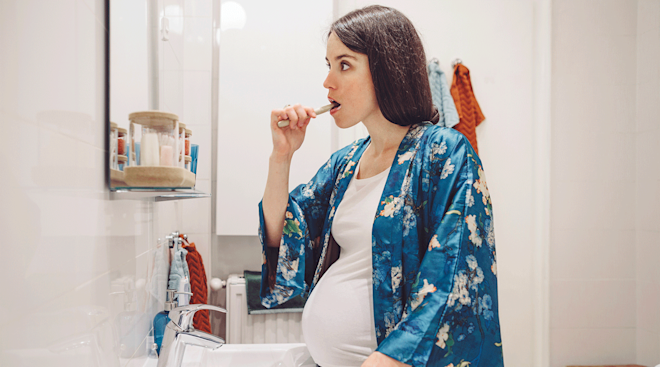Leukorrhea: What to Make of Milky White Discharge During Pregnancy
Vaginal discharge isn’t a topic most of us want to discuss with our friends. But the fact is, every woman experiences some degree of discharge. And that’s actually a very good thing; it helps to keep vaginal tissue healthy and protects against infection, according to the Mayo Clinic. What’s more, it’s very normal to have an increase in discharge when you have a baby on board. It’s called leukorrhea of pregnancy, and it’s no big deal. But it may explain why you’re feeling slightly swampy down there. So what exactly is leukorrhea and what does it look like? We’re sharing everything you need to know about this thin, milky white discharge—plus, some tips to help you feel a bit fresher.
Leukorrhea is the medical term for vaginal discharge, and it’s common to have more of it during pregnancy. In the vast majority of cases, it’s completely normal. But when does leukorrhea start during pregnancy? If you recently learned that you’re expecting, you can also expect an uptick in leukorrhea; early pregnancy is often when many women notice a sudden surge. “Leukorrhea may become more noticeable, especially during the first trimester and toward the end of the third trimester closer to delivery,” says Heather Lopez, MD, an ob-gyn with Hibiscus Women’s Health in Melbourne, Florida. She explains that this is “due to increased blood flow to the vagina as well as an increase in pregnancy hormones.”
Normal vaginal discharge changes throughout a woman’s cycle; as you approach and reach ovulation, cervical mucus may evolve from a cloudy, milky white hue to a more translucent discharge with a stretchy, slippery texture.
You may have a similar thin, milky white discharge during pregnancy, notes the American Pregnancy Association (APA). That’s simply one way to describe the inevitable increase in moisture that occurs during pregnancy; you may also notice an increase in sweat in that general area too, which is also common during pregnancy, according to the Cleveland Clinic. (Chalk it up to those surging hormones.) For most pregnant women, leukorrhea does resemble milk; it’s somewhat watery and white or cloudy. Leukorrhea discharge can even leave a chalky stain on your underwear. Still, there are many variations of “normal” when it comes to leukorrhea in pregnancy, so don’t be surprised if your discharge looks a bit different.
Heather Bartos, MD, medical director at Be. Women’s Health & Wellness in Frisco, Texas, outlines the many different types of leukorrhea discharge: “Normal leukorrhea can be a milky white vaginal discharge that’s opaque,” she says, “but it can also be a bit yellow or even slightly brown.” If it’s more of a clear mucus, that’s fine too. ”But it’s usually thin, unlike the thicker curd-like discharge you typically see with a yeast infection,” she explains.
So how do you know what’s normal and what’s not when it comes to leukorrhea in pregnancy? Just keep an eye out for any changes to the discharge you’re having. “When I talk to my patients about leukorrhea, we discuss that the amount and frequency of leukorrhea can be different for each patient,” says Lopez.
While leukorrhea discharge varies from woman to woman, there are some potential red flags to watch for. “Call your doctor,” Bartos advises, “if the leukorrhea has changed for you—it now has a different smell or it’s blood tinged, meaning there’s a pink or dark brown tinge to it, or if it becomes very irritating and you’re worried that it might be something like yeast or bacterial vaginosis.” When it comes to leukorrhea discharge, you’ll want to reach out to your OB or midwife if you experience any of the following:
- A sudden increase in watery discharge. If you’re experiencing what seems like a constant flow or perpetual dripping of thin, watery fluid, it could indicate a small leak of amniotic fluid instead of leukorrhea. How can you tell the difference? Amniotic fluid leak will keep going and may even smell slightly sweet. Leukorrhea can be annoying, but it won’t gush out and shouldn’t smell like much of anything.
- A greenish tint or foul smell. “It’s important to call your doctor if you notice that the leukorrhea becomes associated with a foul odor, or if it’s causing irritation such as painful urination or a burning sensation in the vagina,” says Lopez. These symptoms may indicate an infection.
- An increase in thickness or chunky white discharge. Leukorrhea is typically thin. If it becomes extra thick or has a chunky white texture, it can be a sign of a yeast infection, per the Cleveland Clinic. Your doctor can treat it to prevent further discomfort and itchiness.
Experiencing extra leukorrhea discharge during pregnancy isn’t usually something to worry about. It can be kind of inconvenient and annoying, though—feeling perpetually damp or oozy down there isn’t particularly pleasant. The key to abating any discomfort is taking proactive steps to make yourself feel dry and fresh. “If leukorrhea during pregnancy is causing irritation or itchiness, it’s okay to use a zinc oxide cream to form a protective barrier,” says Bartos. She also suggests dusting a pinch of cornstarch into your underwear to help absorb some of the excess moisture.
Other helpful tips for dealing with the milky white discharge of pregnancy? Lopez suggests wearing a panty liner and opting for breathable cotton underwear. She also warns against any vaginal douching.
Leukorrhea isn’t the most glamorous side effect of pregnancy, but it’s not something to stress about either. Remember: That thin, milky white discharge is helping keep your vagina clean, and it should eventually subside. Of course, if you have any concerns about normal (or abnormal) leukorrhea or anything else, reach out to your doctor.
Please note: The Bump and the materials and information it contains are not intended to, and do not constitute, medical or other health advice or diagnosis and should not be used as such. You should always consult with a qualified physician or health professional about your specific circumstances.
Plus, more from The Bump:
Heather Lopez, MD, is an ob-gyn with Hibiscus Women’s Health in Melbourne, Florida. She earned her medical degree from Florida State University in Tallahassee.
Heather Bartos, MD, is the medical director of Be. Women’s Health & Wellness in Frisco, Texas. A Navy veteran, she spent 12 years serving the women and spouses of the armed forces, and was an associate professor at the Uniformed Services University of Health Sciences in Bethesda, Maryland. She completed her residency at Baylor College of Medicine, and earned her medical degree at The University of Texas.
Mayo Clinic, Vaginal Discharge, April 2023
American Pregnancy Association, Vaginal Discharge During Pregnancy
Cleveland Clinic, Vaginal Odor, October 2022
Cleveland Clinic, Vaginal Discharge, July 2022
Cleveland Clinic, Is It Normal To Have Thick, White Vaginal Discharge?, July 2022
Learn how we ensure the accuracy of our content through our editorial and medical review process.
Navigate forward to interact with the calendar and select a date. Press the question mark key to get the keyboard shortcuts for changing dates.




















































